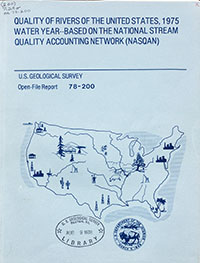Quality of rivers of the United States, 1975 water year; based on the National Stream Quality Accounting Network (NASQAN)
Links
- Document: Report (pdf)
- Download citation as: RIS | Dublin Core
Abstract
The National Stream Quality Accounting Network (NASQAN) was established by the U.S. Geological Survey to provide a nationally uniform basis for continuously assessing the quality of U.S. rivers. Stations generally are at the downstream end of hydrologic accounting units in order to measure the quantity and quality of water flowing from the units. The 1975 water year was the first year of operation of the network that represents essentially all of the accounting units and thereby describes the water- quality of the entire country. Data are available on a large number of water-quality constituents measured at 345 stations during the 1975 water year.
Temperature data (usually continuous or daily measurements) from NASQAN stations were fitted to a first order harmonic equation and the parameters for the harmonic function are reported for each station. Mean temperatures generally range from 5°-10°C in the North to more than 20°C along the southern border of the continental United States and in Hawaii and Puerto Rico; means were less than 10°C at 63 stations and greater than 25°C at only 7 stations. Amplitudes of the temperature curves are greatest (greater than 12°C) for the streams at midlatitudes and in the Great and Central Plains, and they are smallest for the subtropical and cold-climate streams.
Considering chemical and biological characteristics of U.S. streams as described by NASQAN data, water quality is best (by many standards) in the Northeast, Southeast, and Northwest. Waters there generally are low in dissolved solids and major and minor chemical constituents, generally are soft (except in Florida), and carry relatively small amounts of sediment. These conditions mainly reflect the geology of the regions and the relatively large amounts of precipitation. However, many of these waters show the effects of pollution and carry moderate or high levels of major nutrients and have correspondingly high populations of attached and floating plants. High counts of indicator bacteria also show signs of local pollution, particularly in regions of the country with large human and animal populations. In the Northeast, some heavy metals are at moderate levels, but not above most water-quality criteria.
Rivers of most of the Mid-Continent and Southwest reflect the arid or semi-arid climate, erodible soils, and agricultural activities. They are characterized by moderate to high levels of dissolved major and minor constituents, sediment, major nutrients, and biota (floating and attached aquatic plants and indicator bacteria). In addition, the most incidences of pesticides in stream and bottom sediments were found in these regions.
A special analysis was made to study the patterns of dissolved solids, major nutrients, phytoplankton, and zinc in the Mississippi River above Memphis, Tennessee. It was found that flow volume is an important factor in influencing river quality, and that stations with low concentration of major nutrients generally had low phytoplankton populations as well.
Study Area
| Publication type | Report |
|---|---|
| Publication Subtype | USGS Numbered Series |
| Title | Quality of rivers of the United States, 1975 water year; based on the National Stream Quality Accounting Network (NASQAN) |
| Series title | Open-File Report |
| Series number | 78-200 |
| DOI | 10.3133/ofr78200 |
| Year Published | 1977 |
| Language | English |
| Publisher | U.S. Geological Survey |
| Publisher location | Reston, VA |
| Description | viii, 436 p. |
| Country | United States |


